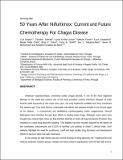Current and future chemotherapy for Chagas disease
Abstract
American trypanosomiasis, commonly called Chagas disease, is one of the most neglected illnesses in the world and remains one of the most prevalent chronic infectious diseases of Latin America with thousands of new cases every year. The only treatments available have been introduced five decades ago. They have serious, undesirable side effects and disputed benefits in the chronic stage of the disease – a characteristic and debilitating cardiomyopathy and/or megavisceras. Several laboratories have therefore focused their efforts in finding better drugs. Although recent years have brought new clinical trials, these are few and lack diversity in terms of drug mechanism of action, thus resulting in a weak drug discovery pipeline. This fragility has been recently exposed by the failure of two candidates, posaconazole and E1224, to sterilely cure patients in phase 2 clinical trials. Such setbacks highlight the need for continuous, novel and high quality drug discovery and development efforts to discover better and safer treatments. In this article we will review past and current findings on drug discovery for Trypanosoma cruzi made by academic research groups, industry and other research organizations over the last half century. We will also analyze the current research landscape that is now better placed than ever to deliver alternative treatments for Chagas disease in the near future
Citation
Gaspar , L , Moraes , C B , Freitas-Junior , L H , Ferrari , S , Costantino , L , Costi , M P , Coron , R P , Smith , T K , Siqueira-Neto , J L , McKerrow , J H & Cordeiro-da-Silva , A 2015 , ' Current and future chemotherapy for Chagas disease ' , Current Medicinal Chemistry , vol. 22 , no. 37 , pp. 4293-4312 . https://doi.org/10.2174/0929867322666151015120804
Publication
Current Medicinal Chemistry
Status
Peer reviewed
ISSN
0929-8673Type
Journal article
Description
Luís Gaspar is thankful to FCT for funding (scholarship reference: SFRH/BD/81604/2011). The research leading to these results has received funding from the European Community’s Seventh Framework Programme under grant agreement No.602773 (Project KINDRED) and No. 603240 (Project NMTrypI).Collections
Items in the St Andrews Research Repository are protected by copyright, with all rights reserved, unless otherwise indicated.

